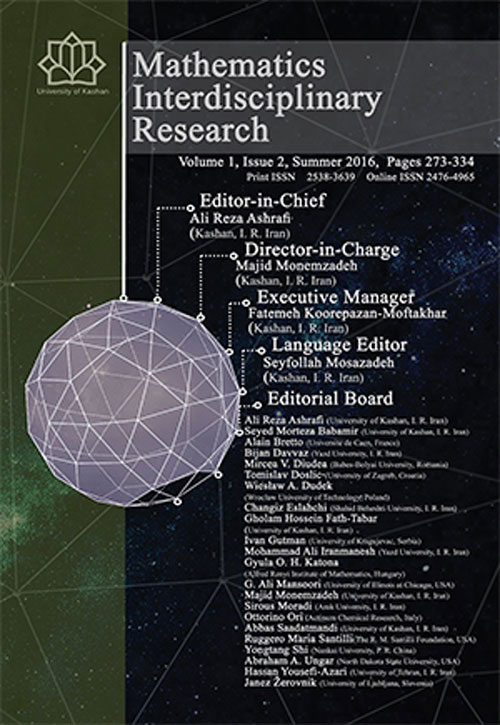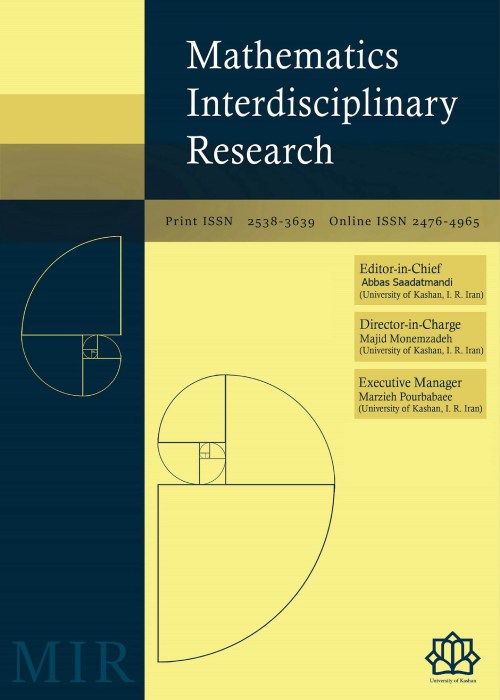فهرست مطالب

Mathematics Interdisciplinary Research
Volume:5 Issue: 2, Autumn 2020
- تاریخ انتشار: 1399/06/01
- تعداد عناوین: 6
-
-
Pages 71-86
This paper provides the fractional derivatives of the Caputo type for the sinc functions. It allows to use efficient numerical method for solving fractional differential equations. At first, some properties of the sinc functions and Legendre polynomials required for our subsequent development are given. Then we use the Legendre polynomials to approximate the fractional derivatives of sinc functions. Some numerical examples are introduced to demonstrate the reliability and effectiveness of the introduced method.
Keywords: Sinc functions, Fractional derivatives, Collocation method, caputo derivative -
Pages 87-102Given a graph G and a positive integer d, an L(d,1)-labelling of G is a function f that assigns to each vertex of G a non-negative integer such that if two vertices u and v are adjacent, then |f(u)-f(v)|>= d and if u and v are at distance two, then |f(u)-f(v)|>= 1. The L(d,1)-number of G, λd(G), is the minimum m such that there is an L(d,1)-labelling of G with f(V)⊆ {0,1,… ,m}. A tree T is of type 1 if λd(T)= Δ +d-1 and is of type 2 if λd(T)>= Δ+d. This paper provides sufficient conditions for λd(T)=Δ+d-1 generalizing the results of Wang [11] and Zhai, Lu, and Shu [12] for L(2,1)-labelling.Keywords: L(d, 1)-labelling, tree, Distance, Δ-vertex
-
Pages 103-111Bucket recursive trees are an interesting and natural generalization of recursive trees. In this model the nodes are buckets that can hold up to b>= 1 labels. The (modified) Zagreb index of a graph is defined as the sum of the squares of the outdegrees of all vertices in the graph. We give the mean and variance of this index in random bucket recursive trees. Also, two limiting results on this index are given.Keywords: Bucket recursive tree, the Zagreb index, limiting rule
-
Pages 113-130
In this paper, we consider the dynamical dark energy model (Feng model) to reveal the discrepancy between CMB and LSS data raised by ΛCDM model. In order to constrained free parameters, we utilize two combined sets namely the Planck TT 2015+Pol+BAO and the WL+RSD. We find that, there is a tension between the best fit values for both σ8 and H0 derived by the early and late time observations in the context of ΛCDM model, while the mentioned discrepancy is alleviated in the Feng model. Two dimensional likelihood analysis demonstrate that including dynamical dark energy model alleviates H0 − Ωm and σ8 − Ωm tension from 2σ to 1σ confidence level compared to that of given for ΛCDM. Besides these, the models satisfy fσ8 data in 0 < z < 0.4 redshift bin but for z > 0.4, the models behave differently rather than data for both data sets.
Keywords: Dynamical Dark Energy Models, Tension, Structure Formation -
Pages 131-155
This paper introduces the novel concept of KM-single valued neutrosophic metric spaces as an especial generalization of KM-fuzzy metric spaces, investigates several topological and structural properties and presents some of its applications. This study also considers the metric spaces and constructs KM-single valued neutrosophic spaces with respect to any given triangular norms and triangular conorms. Moreover, we try to extend the concept of KM-single valued neutrosophic metric spaces to a larger class of KM-single valued neutrosophic metric spaces such as union of KM-single valued neutrosophic metric spaces and product of KM-single valued neutrosophic metric spaces
Keywords: KM-single valued neutrosophic metric, left-continuous triangular (co)norm, Cauchy sequence -
Pages 157-172
In this paper, we present a new high order explicit four-step method of eighth algebraic order for solving second-order linear periodic and oscillatory initial value problems of ordinary differential equations such as undamped Duffing's equation. Numerical stability and phase properties of the new method is analyzed. The main structure of the method is multiderivative, and the combined phases were applied to expand the stability interval and to achieve P-stability. The advantage of the method in comparison with similar methods in terms of efficiency, accuracy, and stability is shown by its implementation in some well-known problems.
Keywords: Phase-lag error, Initial value problems, P-stable, Symmetric multistep methods, Periodicity interval


